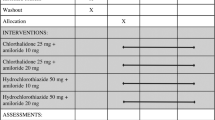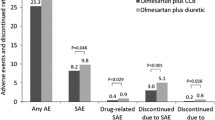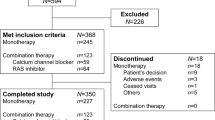Summary
The antihypertensive effect of carteolol, a new β-blocking agent, added to basal diuretic treatment (hydrochlorthiazide 50 mg and amiloride 5 mg) has been assessed in a controlled trial in 17 patients with mild-to-moderate hypertension. The trial was divided into 4 stages: 1) run-in period with no antihypertensive treatment, 2) diuretic period (the diuretic being continued as basal treatment during the two following periods), 3) carteolol titration period, and 4) double-blind cross-over period comparing carteolol with placebo, which lasted 2 times 4 weeks. Although the diuretic effectively reduced the blood pressure, 17 of the 20 patients originally studied still had an elevated diastolic blood pressure (≧ 95 mmHg) after the diuretic period, thus fulfilling the inclusion criteria for the study. During the titration period carteolol 5 to 20 mg b. i. d. significantly reduced the elevated blood pressure. The blood pressure was reduced to normal in all 17 patients, although in two patients this occurred only during the double-blind period. During the double-blind period, the dose of carteolol was used which had given a satisfactory response during the titration period. The blood pressure in the 14 patients who completed the trial remained low both with carteolol and placebo during the double-blind stage, and was only slightly lower with carteolol than with placebo. This is probably due to a “carry-over” effect. Three patients discontinued the trial due to side effects (1 urticaria, 1 insomnia and 1 nausea) while on carteolol. There was no other difference between carteolol and placebo in the number or severity of side effects.
Similar content being viewed by others
References
Fitzgerald JD (1969) Perspectives in adrenergic beta-receptor blockade. Clin Pharmacol Ther 10: 292–306
Gugler S, Herold W, Dengler HJ (1974) Pharmacokinetics of pindolol in man. Eur J Clin Pharmacol 7: 17–24
Hashimoto K, Kimura T, Yabuuchi Y (1976) Comparison of newly synthesized beta-adrenergic blockers, OPC-1085 and SQ 111725, with pindolol and propranolol in the blood-perfused canine SA node and papillary muscle preparations. Jpn J Pharmacol 25: 504–506
Hiyama T, Fujita K, Douburi J, Nishino H, Yamashita S, Uno T, Shintani S, Nishi M, Tei S, Toba Y, Yabuuchi Y (1976) The general pharmacological studies of a newβ-adrenergic blocking agent carteolol, 5-(3-tert-butylamino-2-hydroxy)propoxy-3,4-dihydrocarbostyril hydrochloride, OPC-1085. Pharmacometrics 11: 437–461
Kohri H, Morita S, Nakagawa K, Nishino H (1976) Metabolic fate of carteolol hydrochloride, a new beta blocking agent. III total body distribution studies in mice. Folia Pharmacol Japon 72: 341–350
Morita S, Iinuma M, Kido M, Sakuragi S, Kohri H, Nishino H (1977) Metabolic fate of carteolol hydrochloride (OPC-1085) VIII, a newβ-adrenergic blocking agent. Pharmacokinetic studies of carteolol in man. Arzneim Forsch 27: 2380–2383
Nakagawa K, Murakami N, Yoshizaki S, Tominaga M, Mori H, Yabuuchi Y, Shintani S (1974) Derivatives of 3,4-dihydrocarbostyril asβ-adrenergic blocking agents. J Med Chem 17: 529–533
Niki T, Yui Y, Veda M, Kondo C, Matsumura K, Nakaya Y, Kitanaka Y, Mori H (1975) Antagonism of OPC-1085, carteolol, a new potentβ-adrenergic blocking agent, to positive chronotropic action by exercise and isoproterenol infusion in normal subjects: Comparison with the action of propranolol and pindolol. Heart 7: 1151–1155
Sekiya A (1975) The relevance of beta-adrenergic blocking agents and local anesthetic action to ouabain-induced cardiac arrythmias of 5-(3-tert-butylamino-2-hydroxy) propoxy-3,4-dihydrocarbostyril hydrochloride (OPC-1085) Pharmacometrics 9: 357–362
Takenaka F, Shintani S, Ishihara S, Higuchi M, Hiraki K (1975) Effects of 5-(3-tert-butylamino-2-hydroxy) propoxy-3,4-dihydrocarbostyril hydrochloride (OPC-1085) on coronary circulation and myocardial metabolism. Folia Pharmacol Japon 71: 221–230 (1975)
Veterans Administration Cooperative Study Group on Antihypertensive Agents (1975) Return of elevated blood pressure after withdrawal of antihypertensive drugs. Circulation 51: 1107–1113
Wilson M, Morgan G, Morgan T (1976) The effect on blood pressure of β-adrenoceptor blocking drugs administered once daily and their duration of action when therapy is ceased. Br J Clin Pharmacol 3: 857–861
Yabuuchi Y, Kinoshita D (1974) Cardiovascular studies of 5-(3-tert-butylamino-2-hydroxy) propoxy-3,4-dihydrocarbostyril hydrochloride (OPC-1085), a new potentβ-adrenergic blocking agent. Jpn J Pharmacol 24: 853–861
Author information
Authors and Affiliations
Rights and permissions
About this article
Cite this article
Tarkiainen, A., Saraste, K., Seppälä, T. et al. A controlled study of the antihypertensive effect of carteolol, a newβ-adrenergic receptor blocking drug, in combination with hydrochlorthiazide and amiloride. Eur J Clin Pharmacol 19, 239–244 (1981). https://doi.org/10.1007/BF00562799
Received:
Revised:
Accepted:
Issue Date:
DOI: https://doi.org/10.1007/BF00562799




